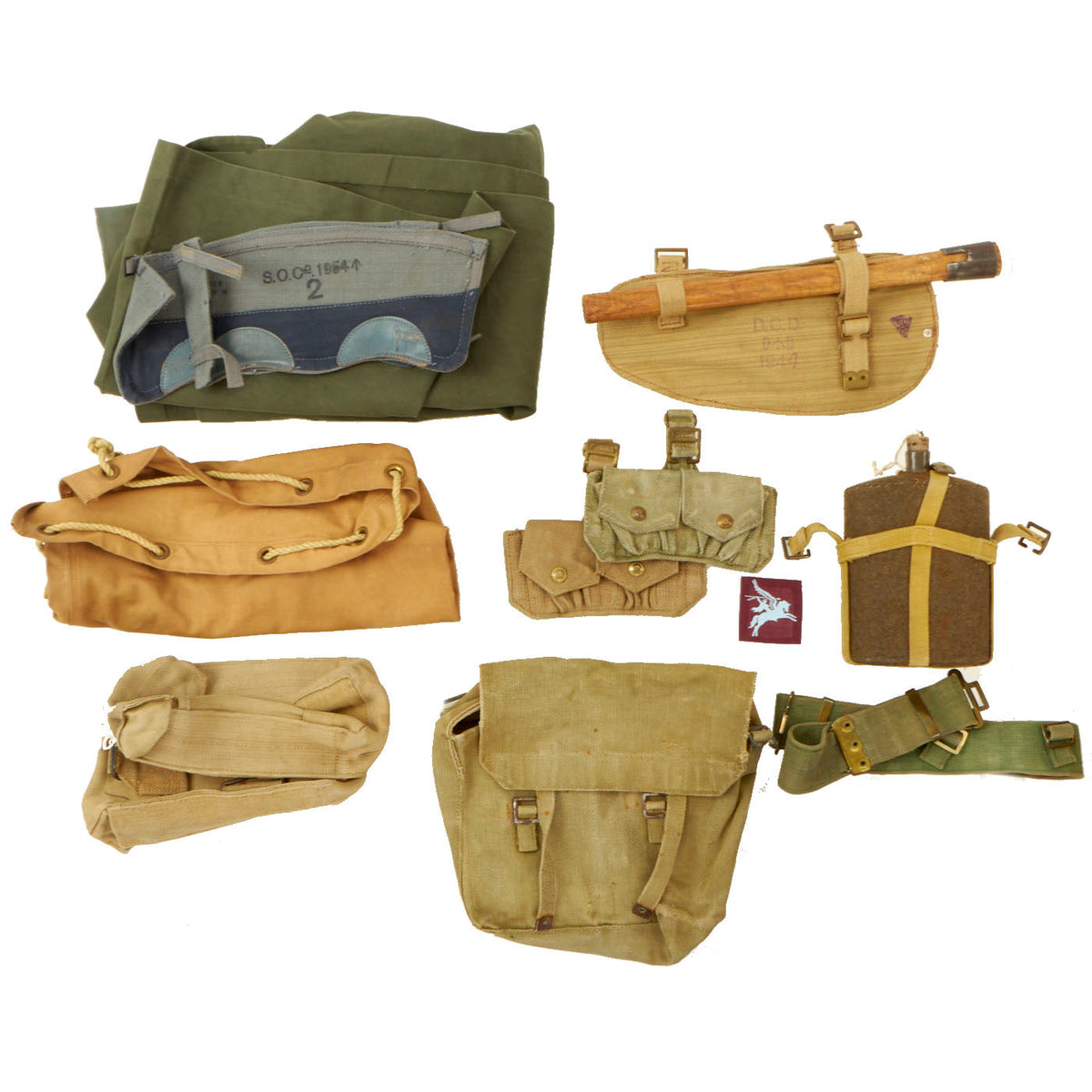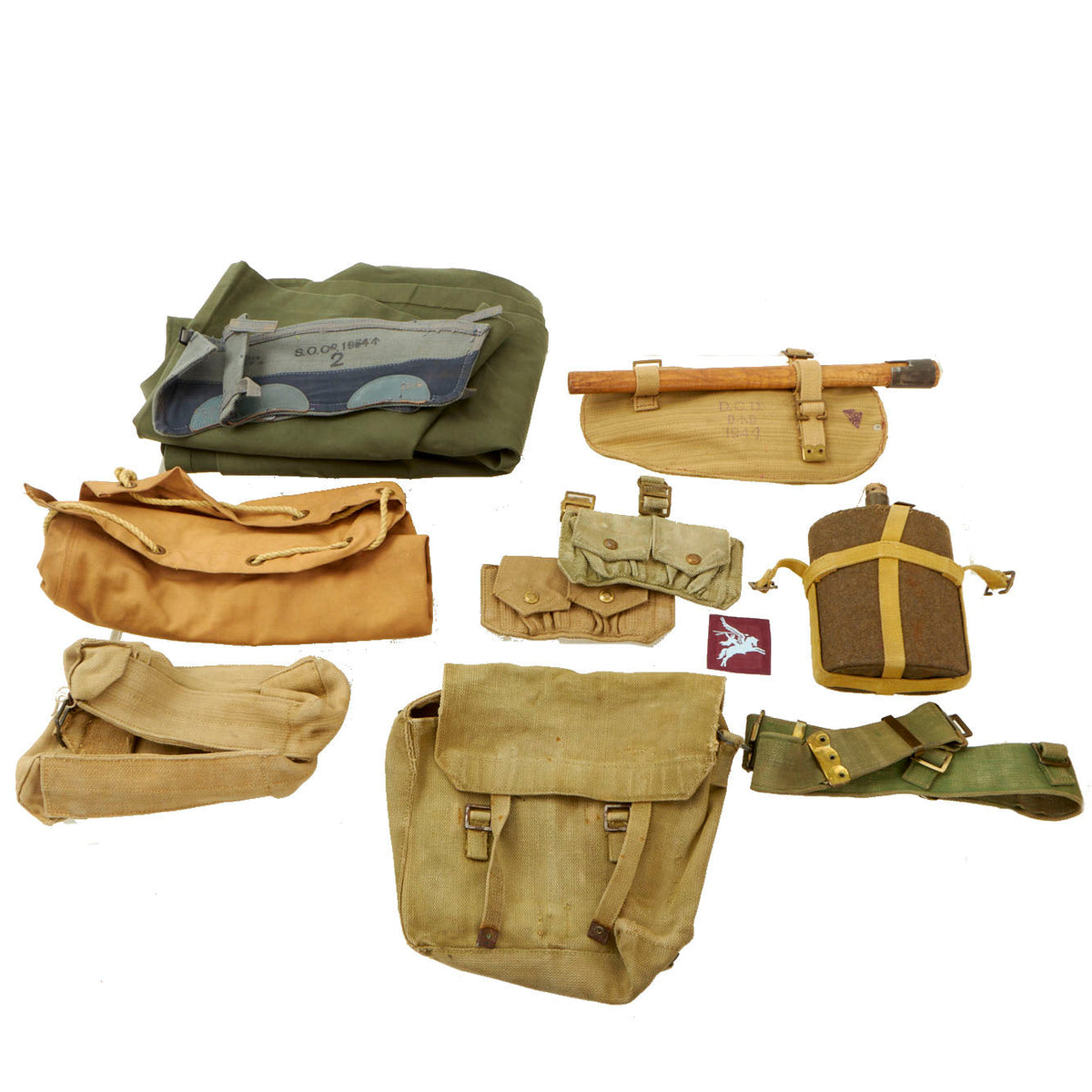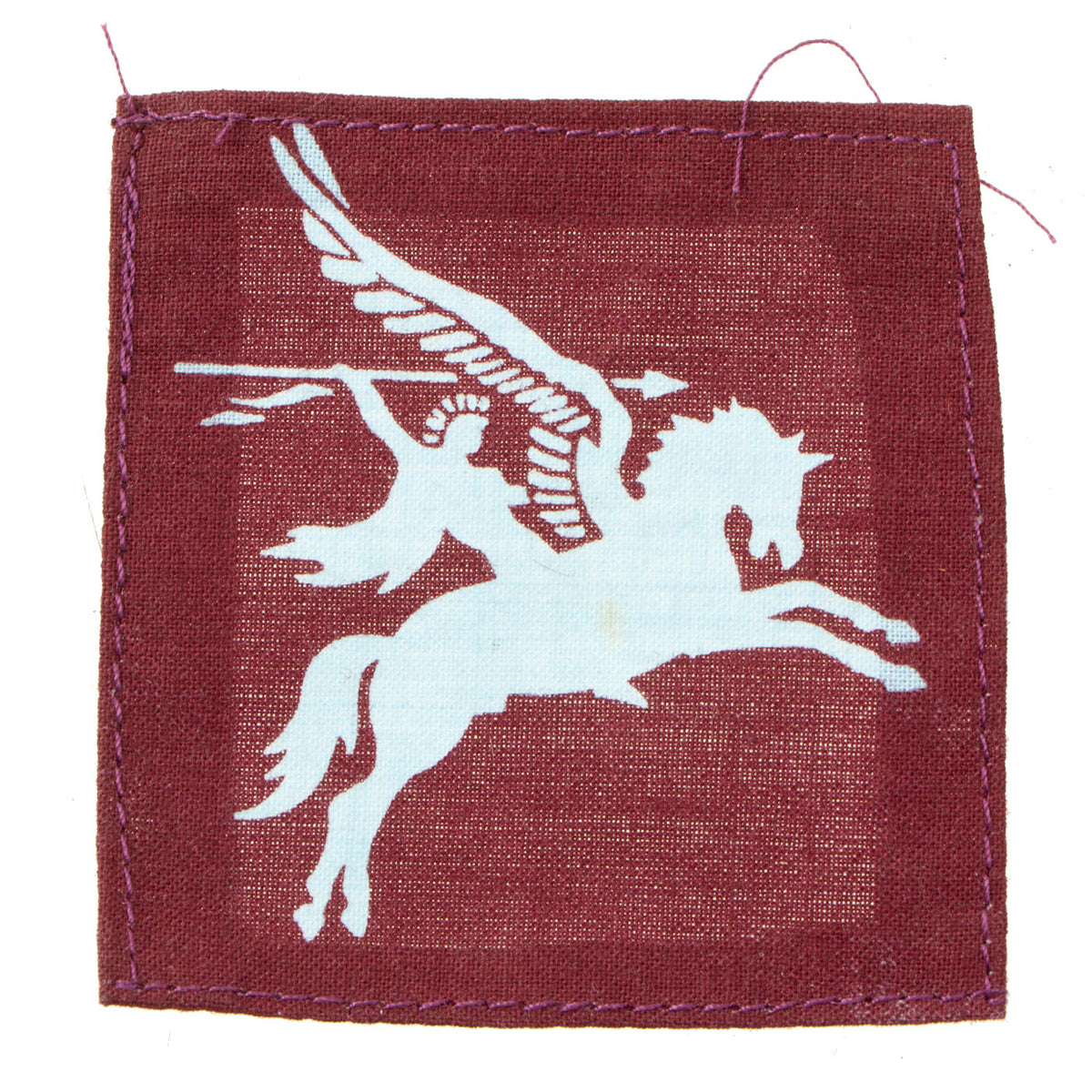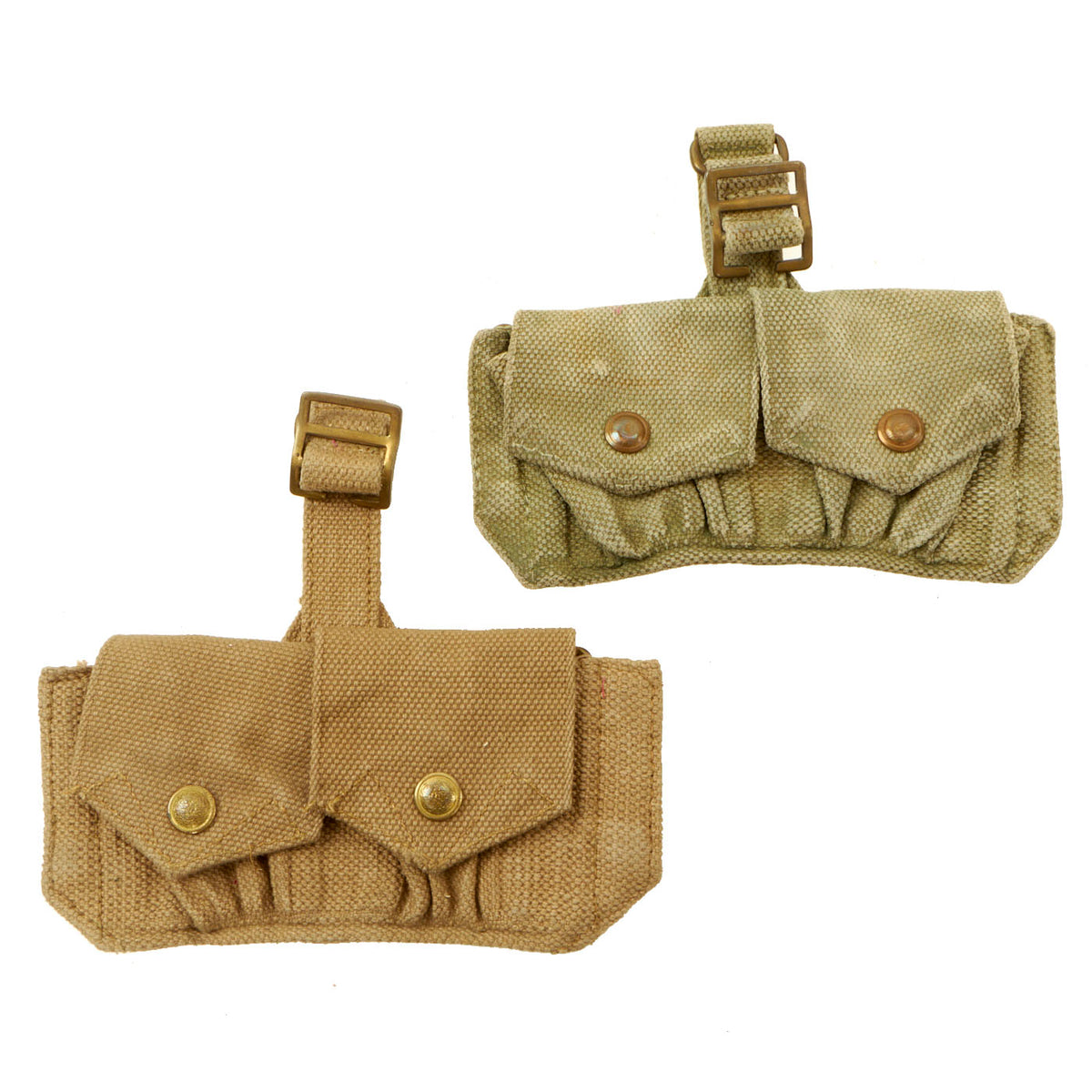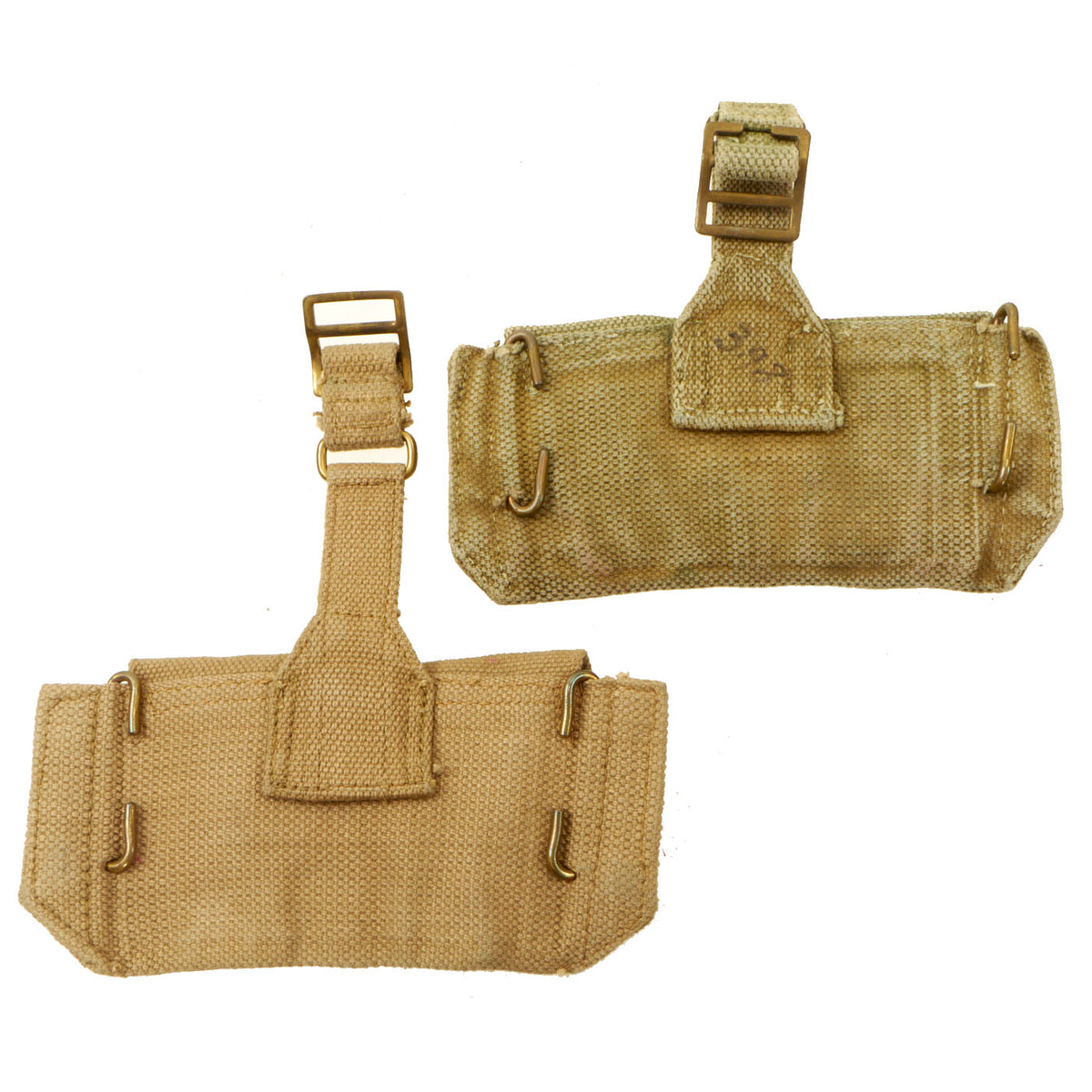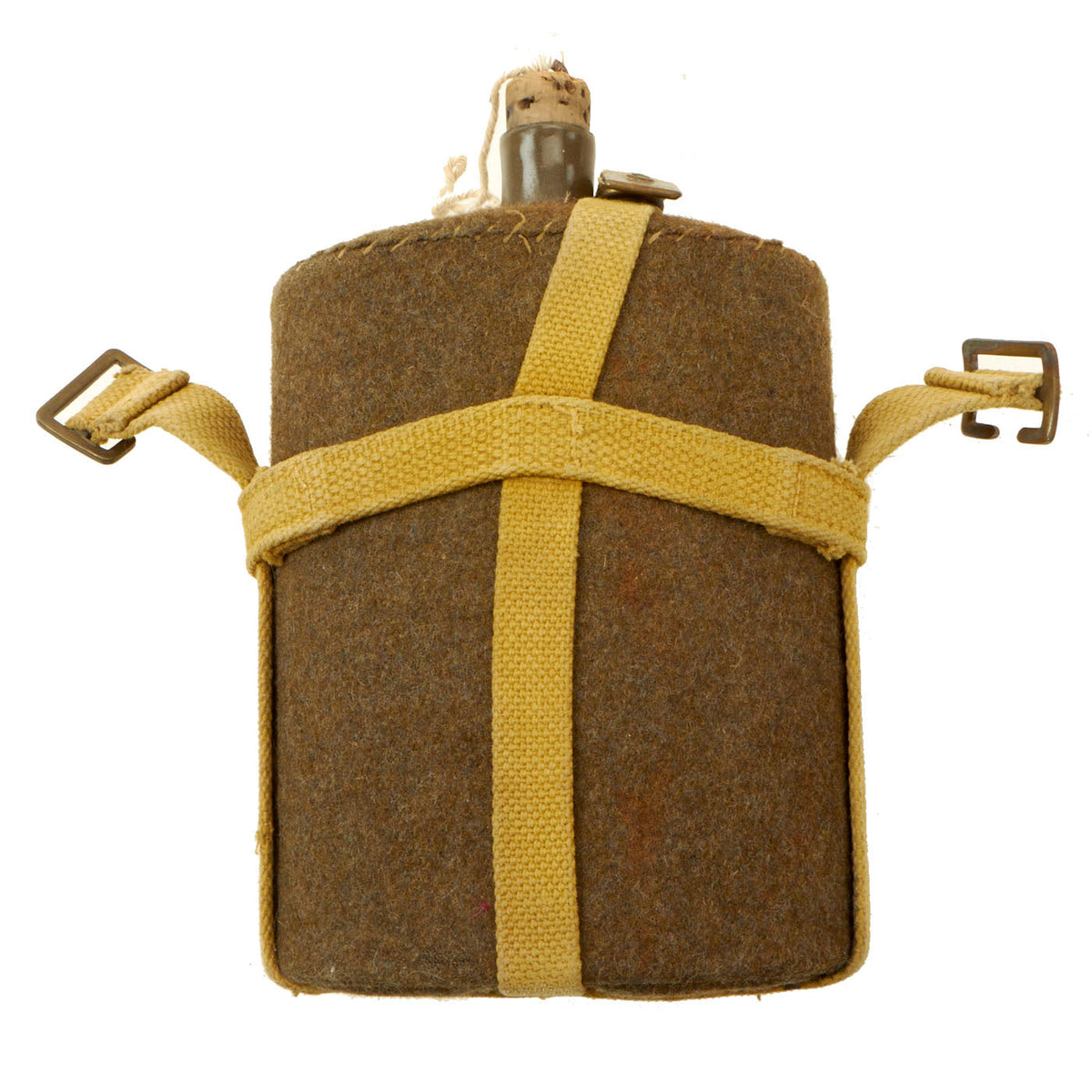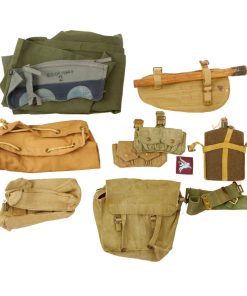Original British WWII Royal British Army Field Gear Lot – 13 Items Original Items
$ 295,00 $ 118,00
Original Items: Only One Lot of 13 Available. This is a lovely assortment of British WWII field gear items. All are free of extensive damage and most still have original stampings with the date of 1944! Truly a wonderful opportunity to add some amazing items to complete your displays!
The items featured in this lot:
– 1937 Pattern Green “Pistol” Belt: These belts were worn around the waist and clipped together at the front using the ‘hook and loop’ buckle. They also have the two buckles at the back for attaching to the braces.
– x2 1937 Pattern Double Cartridge Pouch: A horizontal rectangular case with two square pouches that carried a total of 20 rounds (4 × 5-round clips). It was designed for use by non-infantry soldiers who carried a rifle. Each pouch contained (2) 5-round chargers that were separated by a cloth divider. The pouch had two snaps: the bottom snap was used if only one clip was carried and the top snap was used if both clips were carried. The back of the carrier attached to the web belt with two long oval metal hooks and the top had a strap that linked into the shoulder strap.
– x2 1937 Pattern Mk2 Basic Pouches: A large vertical rectangular pouch that went through three versions (Marks I, II, and III). It could carry either (2) BREN magazines, (6) 20-round Thompson SMG magazines, (4) No 36M Fragmentation, No 69 Offensive, or No.77 White Phosphorus grenades, (4) No 36M cup-discharger rifle grenades with attached gas-check baseplates, (2) Smoke Grenades, or boxes of Small Arms Ammunition. The Mark I version had three cartridge loops sewn into the inner lid for carrying three ballistite Rifle Grenade Blanks for launching rifle grenades; this feature was later omitted on the Mark II pouch. The longer Basic Pouch Mark III could hold (5) 32-round STEN Machine Carbine Magazines.
– Pattern 1937 Entrenching Tool WITHOUT Bayonet Lug: The 37 pattern webbing set originally included a small shovel for entrenching. This was found to be pretty useless and it was decided to reintroduce the ‘sirhind’ type of entrenching tool used with the 08 pattern web set. This entrenching tool obviously needed a carrier, so the designers at Mills took the old 08 entrenching tool cover and modified it for use with 37 pattern webbing. The design included the same kidney shaped webbing bag as the old 08 pattern design, and it was into this that the head of the entrenching tool was placed. The British 1937 Pattern entrenching tool added a bayonet lug to the tool’s handle, allowing the Lee-Enfield spike bayonet to be mounted on the end and converting the tool into a mine prodder.
– Post WWII RAF Blue Ankle Gaiters
– Pattern 1937 MkVI Canteen and Carrier:
– Pattern 1937 “All Ranks” Haversack: A rectangular bag that attached to the brace ends on the left hip. It was partitioned in the middle and the rear partition was split in two, with the two Mess Tins stored in one side and the Mark VII Water Bottle and its webbing harness stored in the other side. It was worn on the back when the large pack was not worn. In this case, the poncho was folded so as to cushion the back and was visible under the flap.
– 1942 Unissued Mk2 Kit Bag by Man. Tent & Awning Co.
– Rain Poncho/Cape
– New Made British Airborne “Pegasus” Patch
These are all lovely items ready for display!
1937 Pattern Web Equipment
1937 Pattern Web Equipment (also known as ’37 Webbing’) was an item of military load-carrying equipment. It replaced the 1908 Pattern and 1925 Pattern—on which it was based—and was standard issue for British and Commonwealth troops from its introduction in 1937, throughout World War II, and in the post-war period until it was superseded by 58 pattern webbing.
At the end of the First World War, huge stocks of 1908 Pattern equipment remained, and the difficult financial climate meant that these remained in service with the British Army in the post-war period. In 1932, the Chief of the Imperial General Staff established the Brathwaite Committee to look into the uniform and equipment of the infantry and to make recommendations for their improvement. The increasingly complex nature of combat and different roles that soldiers and members of the other services were being required to undertake, meant that the new design needed to be flexible, thus it was decided that it would consist of interchangeable components, which could be modified to suit the individual needs of a soldier based on his role. In 1932, the Mills Equipment Company, the prime manufacturer of the 1908 equipment, offered the Brathwaite Committee four new designs to consider. Although the committee decided on one of the designs in 1934, the ongoing trials to find a successor to the Lewis gun that resulted in the Bren gun, and also abortive trials of automatic rifles including the Pedersen rifle, meant that new webbing could not be adopted until decisions had been reached on future weaponry.
The design was confirmed on 8 June 1938 and wide-scale issue began in 1939. Towards the end of World War II, some 37 Webbing was produced in jungle green for troops fighting in the Pacific Theater, although purpose-made 44 Pattern Webbing was then introduced for the humid jungle conditions, being lighter in weight, quicker drying and rot-proofed. Although 44 Pattern continued in use with the British Army for jungle warfare in its various post-World War II colonial conflicts, it did not replace 37 Pattern in general service, which was in front-line use up until the introduction of 58 Pattern. However, 37 Pattern was used for second line and support troops and was included in the army’s Catalog of Ordnance Stores and Ammunition (C.O.S.A.) in 1985, but had finally disappeared by the time of the 1991 edition.
1937 Pattern Webbing was made from cotton webbing, which was waterproofed and dyed before being woven. The fittings were made of stamped brass—blackened steel post war—and it was produced by various manufacturers. It was produced in a khaki color for the Army, which could then be dyed with Blanco, most often pea green (a light-green shade) and blue-grey for the Royal Air Force. Military Police had white webbing.
Standard components included a belt (issued in sizes Normal and Large), cross straps (called ‘braces’), cartridge pouches for .303 ammunition (which gave way to ‘universal’ pouches to carry ammunition for an array of infantry weapons then in use by the British Army, in addition to grenades), a carrier for the water bottle and a small pack. The large (1908) pack—intended to be carried in regimental transport except when in full marching order—and entrenching tool carriers were retained from World War I issue, although the later was initially issued in modified form before being reintroduced in 1941. Frogs for the 1907 SMLE and No.4 Rifle bayonets were also issued. Different combinations of these components comprised the ‘marching order’ and the ‘battle order’ respectively. In addition various items were issued to be used by officers and often armored crewmen, such as pouches for binoculars, pistol ammunition and compass (externally the same as that for pistol ammunition but with felt padding inside), as well as a ‘valise’ side pack and holster for the .38 revolver (a tank crew version with leg strap also existed in two versions). The theoretical weight of the fully loaded equipment was 56 pounds (25 kg) for an infantryman in full marching order, including a rifle but not helmet or gas cape, and 42 pounds (19 kg) for an officer.
A number of items were issued which conformed to 37 Pattern in their fittings and materials but were not strictly part of the set, such as a bandolier for Sten magazines as issued to airborne troops and the spare barrel bag and parts wallet for the Bren gun.
Fast Shipping with Professional Packaging
Thanks to our longstanding association with UPS FedEx DHL, and other major international carriers, we are able to provide a range of shipping options. Our warehouse staff is expertly trained and will wrap your products according to our exact and precise specifications. Prior to shipping, your goods will be thoroughly examined and securely secured. We ship to thousands clients each day across multiple countries. This shows how we're dedicated to be the largest retailer on the internet. Warehouses and distribution centres can be located throughout Europe as well as the USA.
Note: Orders with more than one item will be assigned a processing date depending on the item.
Before shipping before shipping, we'll conduct a thorough inspection of the items you have ordered. Today, the majority of orders will be delivered within 48 hours. The delivery time will be between 3-7 days.
Returns
The stock is dynamic and we cannot completely manage it because multiple stakeholders are involved, including our factory and warehouse. So the actual stock may alter at any time. It's possible that you may not receive your order once the order has been made.
Our policy is valid for a period of 30 days. If you don't receive the product within 30 days, we are not able to issue a refund or an exchange.
You can only return an item if it is unused and in the same state as the day you received it. You must have the item in its original packaging.
Related products
Uncategorized
Uncategorized
Uncategorized
Uncategorized
Armored Burgonet Helmet & Polearm from Scottish Castle Leith Hall Circa 1700 Original Items
Uncategorized
Uncategorized
Uncategorized
Uncategorized
Uncategorized
Band of Brothers ORIGINAL GERMAN WWII Le. F.H. 18 10.5cm ARTILLERY PIECE Original Items
Uncategorized
Uncategorized
Uncategorized
Australian WWII Owen MK1 Machine Carbine SMG Custom Fabricated Replica with Sling Original Items
Uncategorized
Uncategorized
Uncategorized
Angolan Rebel 1970s era 60mm Inert Display Mortar from Angolan Civil War Original Items
Uncategorized
Uncategorized
Uncategorized
Uncategorized
